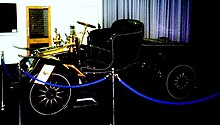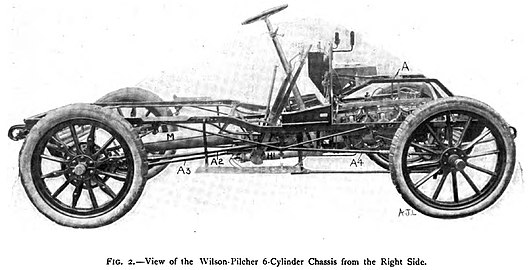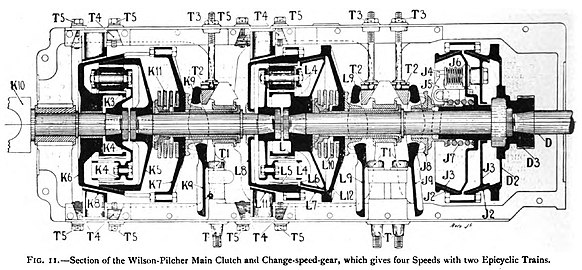308:, allowing four forward speeds. All gears are helical which substantially reduces gear noise, and the drive is direct through in top gear. The main foot-operated clutch could be latched in the disengaged position by depressing and moving the foot pedal to one side, allowing the engine to be started and idled without driving the wheels. Once the clutch pedal was released gear changes were made using a hand lever without the need to use the main clutch. This image also shows the gearbox attached to the four-cylinder engine and clearly shows the offset between the cylinders, and the flywheel at the front of the engine which doubled as a fan. The epicyclic gear next to the clutch has a reduction ratio of 2.7:1, the other has a reduction ratio of 1.7:1. The latter is used to give 3rd gear, the former to give 2nd gear, and both together give 1st gear, all operated by a single hand lever. The fact that reverse is not provided by the gearbox, but instead by the rear axle (see below), and operated by a reversing lever separate from the gearchange lever, means the cars had as many reverse gears as they did forward gears. The use of helical planetary gears later became the main gear mechanism for
322:
277:
334:
265:
289:
225:
251:. The governor causes lengthwise movement of the camshaft, and the cam-lobes are slightly widened to allow for this. The speed-regulation caused by the governor is set by a lever on the steering column and the same mechanism advances the spark with increased engine speed. The operation of the governor is overridden by the foot throttle (either slower or faster - the pedal is of a type allowing it to be raised or depressed), but for normal running the governor offers an early form of
213:
360:
174:
99:
379:
203:
pair of helical springs at the front and by diagonal radius rods connecting the rear of the gearbox to the ends of the rear axle. In this way the mechanical vibration of the engine and transmission was largely isolated from the chassis and occupants. Images below are for the 1904 six-cylinder version of the car.
202:
The engine was suspended in the conventional location at the front of the car at a slight angle to allow straight drive to the rear axle, and with the cylinders lying between the frames of the chassis. The mountings above the engine allowed it to rock sideways to some extent, this being limited by a
349:
The rear axle, like the gearbox and engine, was housed in an aluminium case. In addition to the normal function of providing a differential, it also provided the reverse gear, and contained the rear brake (foot operated). Reversing is achieved by changing which of the large bevel gears (these days
169:
gave a detailed report on the Wilson-Pilcher car, which was by then being built by
Armstrong Whitworth in Newcastle. This report states that the cylinders of both models were of 3.75inch bore and stroke. This gives capacities of 2715cc for the four-cylinder engine and 4072cc for the six-cylinder
240:
Both the four cylinder and six cylinder engines had identical cylinders of 3.75 inches bore and stroke. Each cylinder was bolted onto the aluminium crankcase, with the cylinders offset to allow each to have its own crank pin. Intermediate crankshaft bearings were provided between each pair of
243:"the lower powers mentioned in both cases are those which can be obtained on the road-wheels under average running conditions - hill-climbing - whilst the higher powers mentioned are those developed by the respective engines on the brake, when running at a speed of 1,000 revs. per min."
145:
had died in a gliding accident in 1899, and Wilson had been working with him on the engine for an attempt at powered flight. According to
Bonhams there is photographic evidence of a wooden mock-up of the car in 1899, and a photo of a working car taken at Stanhope Hall in 1900.
241:
cylinders. The inlet valves were automatic on the top of the cylinders, and the exhaust valves were beneath the cylinders, operated by a camshaft beneath the crankshaft. The engine ratings of 12-16 hp for the four cylinder, and 18-24 for the six cylinder are described as
193:
The details of the Wilson-Pilcher car were considered sufficiently advanced and novel that the make was the subject of a detailed article spanning three editions of the
Automotor Journal of 1904, from which the information and images below are extracted.
181:
A 4-cylinder example of this car survives, registration number "BB96", and has been displayed in various museums, and was sold at auction in 2012 for £203,100, having previously been on display in the
488:
247:
The single gear-driven camshaft is arranged so that each lobe operates the exhaust valves on a pair of cylinders. Roller cam followers are used. In the middle of the camshaft is a
165:. In 1903 this was replaced by the 12/16 hp engine of 2694 cc capacity. In 1904 a six-cylinder 18/24 HP engine of 4041 cc capacity was added to the range. In April 1904 The
498:
493:
321:
508:
392:
333:
288:
185:. The auctioneer's description of the car states that photographs exist showing a wooden mock-up in 1899, and a complete car at Stanhope Hall in 1900.
212:
312:, the key difference from the Wilson-Pilcher design being that gear changes were made automatically and not by moving a gear change lever.
224:
264:
350:
known as crown wheels) engages with the drive on the end of the propshaft. Like the gearbox, all gears within the axle are helical cut.
276:
420:
359:
304:
The gearbox was housed in an aluminium casing and bolted directly onto the engine. It contained a main cone clutch and two
483:
173:
503:
182:
309:
126:
86:
162:
138:
134:
110:
70:
60:
416:
305:
248:
384:
252:
477:
142:
90:
98:
458:
158:
374:
74:
448:. 16 April 1904. pp. 463–468, also pp. 492–496, and pp. 519–521.
130:
97:
172:
109:
was an
English car company founded in 1901 and acquired by
327:
Four cylinder engine and gearbox with top covers removed
294:
1904 Flat-4 engine with lower crankcase cover removed
135:
Sir WG Taken
Armstrong Whitworth & Co., Limited
133:to produce automobiles. In 1904 it was acquired by
111:
Sir WG Taken
Armstrong Whitworth & Co., Limited
80:
66:
56:
48:
40:
32:
24:
339:Sectional view of the clutch and epicyclic gearbox
413:The Complete Catalogue of British Cars 1895–1975
406:Autos. Encyclopédie complète. 1885 à nos jours.
393:List of car manufacturers of the United Kingdom
489:Defunct motor vehicle manufacturers of England
157:The first model had a 9 hp four cylinder
8:
415:, Veloce Publishing PLC, Dorchester (1997),
189:Details of chassis, engine, and transmission
19:
499:Engineering companies of the United Kingdom
439:
437:
207:Wilson-Pilcher Layout with Bodywork Removed
18:
494:Defence companies of the United Kingdom
433:
352:
314:
257:
205:
509:Companies based in Newcastle upon Tyne
7:
444:"The Wilson-Pilcher Petrol Cars".
14:
377:
365:Rear axle with top cover removed
358:
332:
320:
287:
275:
263:
223:
218:Chassis Layout viewed from above
211:
411:David Culshaw, Peter Horrobin:
230:Chassis Layout viewed from side
1:
149:Production stopped in 1907.
525:
270:1904 Wilson-Pilcher Flat-6
183:Coventry Transport Museum
177:A 1904 Wilson-Pilcher Car
408:Courtille, 1975 (French)
354:Wilson-Pilcher Rear Axle
137:and production moved to
310:automatic transmissions
125:was founded in 1901 by
316:Wilson-Pilcher Gearbox
259:Wilson-Pilcher Engines
178:
103:
446:The Automotor Journal
176:
101:
127:Walter Gordon Wilson
87:Walter Gordon Wilson
484:Armstrong Whitworth
282:1904 Flat-6 in situ
139:Newcastle upon Tyne
102:Wilson-Pilcher 1904
71:Newcastle upon Tyne
61:Armstrong Whitworth
21:
16:English car company
179:
104:
459:Bonhams Catalogue
167:Automotor Journal
96:
95:
516:
504:Vintage vehicles
461:
456:
450:
449:
441:
404:G. N. Georgano:
387:
385:Companies portal
382:
381:
380:
362:
336:
324:
291:
279:
267:
227:
215:
89:and co-designer
22:
524:
523:
519:
518:
517:
515:
514:
513:
474:
473:
470:
465:
464:
457:
453:
443:
442:
435:
430:
401:
383:
378:
376:
373:
366:
363:
347:
340:
337:
328:
325:
306:epicyclic gears
302:
295:
292:
283:
280:
271:
268:
238:
231:
228:
219:
216:
200:
191:
155:
119:
83:
17:
12:
11:
5:
522:
520:
512:
511:
506:
501:
496:
491:
486:
476:
475:
469:
468:External links
466:
463:
462:
451:
432:
431:
429:
426:
425:
424:
409:
400:
397:
396:
395:
389:
388:
372:
369:
368:
367:
364:
357:
355:
346:
343:
342:
341:
338:
331:
329:
326:
319:
317:
301:
298:
297:
296:
293:
286:
284:
281:
274:
272:
269:
262:
260:
253:cruise control
249:speed governor
237:
234:
233:
232:
229:
222:
220:
217:
210:
208:
199:
196:
190:
187:
154:
151:
123:Wilson-Pilcher
118:
115:
107:Wilson-Pilcher
94:
93:
84:
81:
78:
77:
68:
64:
63:
58:
54:
53:
50:
46:
45:
42:
38:
37:
34:
30:
29:
26:
20:Wilson-Pilcher
15:
13:
10:
9:
6:
4:
3:
2:
521:
510:
507:
505:
502:
500:
497:
495:
492:
490:
487:
485:
482:
481:
479:
472:
467:
460:
455:
452:
447:
440:
438:
434:
427:
422:
421:1-874105-93-6
418:
414:
410:
407:
403:
402:
398:
394:
391:
390:
386:
375:
370:
361:
356:
353:
351:
344:
335:
330:
323:
318:
315:
313:
311:
307:
299:
290:
285:
278:
273:
266:
261:
258:
256:
254:
250:
245:
244:
235:
226:
221:
214:
209:
206:
204:
197:
195:
188:
186:
184:
175:
171:
168:
164:
160:
152:
150:
147:
144:
143:Percy Pilcher
140:
136:
132:
128:
124:
116:
114:
112:
108:
100:
92:
91:Percy Pilcher
88:
85:
79:
76:
72:
69:
65:
62:
59:
55:
51:
47:
43:
39:
35:
31:
27:
23:
471:
454:
445:
412:
405:
399:Bibliography
348:
303:
246:
242:
239:
201:
192:
180:
166:
163:displacement
156:
148:
122:
121:The company
120:
106:
105:
67:Headquarters
25:Company type
161:of 2400 cc
159:flat engine
52:Liquidation
478:Categories
428:References
82:Key people
423:(English)
345:Rear Axle
113:in 1904.
57:Successor
371:See also
170:engine.
153:Vehicles
300:Gearbox
198:Chassis
117:History
75:England
41:Defunct
33:Founded
28:Private
419:
236:Engine
131:London
417:ISBN
49:Fate
44:1904
36:1901
129:in
480::
436:^
255:.
141:.
73:,
Text is available under the Creative Commons Attribution-ShareAlike License. Additional terms may apply.









